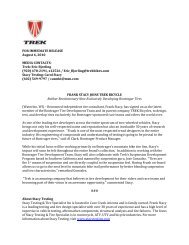Airfoil Development for the Trek Speed Concept ... - Slowtwitch.com
Airfoil Development for the Trek Speed Concept ... - Slowtwitch.com
Airfoil Development for the Trek Speed Concept ... - Slowtwitch.com
You also want an ePaper? Increase the reach of your titles
YUMPU automatically turns print PDFs into web optimized ePapers that Google loves.
Glossary<br />
** Note: terms are terms defined as <strong>the</strong>y are used in this paper. **<br />
<strong>Airfoil</strong>:<br />
Aspect Ratio: <br />
Boundary Layer:<br />
CFD:<br />
The 2D cross-section of a bicycle tube. Typically, this is a streamlined aerodynamic shape defined in <strong>the</strong><br />
waterline plane.<br />
The ratio of <strong>the</strong> major chord (length) to <strong>the</strong> minor chord (width) of a 2D airfoil. This is a departure from <strong>the</strong><br />
aeronautical industry, which defines aspect ratio using <strong>the</strong> wingspan.<br />
The layer of slower-moving fluid immediately next to <strong>the</strong> airfoil wall.<br />
Computer software which simulates fluid flows and can be used to predict aerodynamics. Stands <strong>for</strong><br />
Computational Fluid Dynamics.<br />
Major & Minor Chord:<br />
End-Effects: The flow across <strong>the</strong> end of a finite-length airfoil section which generally increases drag and reduces lift [8].<br />
KVF:<br />
NACA <strong>Airfoil</strong>s:<br />
Pitch:<br />
<strong>Trek</strong>’s trade name <strong>for</strong> its breakthrough airfoil design which, at a low aspect ratio, achieves nearly all of <strong>the</strong><br />
immense aerodynamic and stiffness benefits of an o<strong>the</strong>rwise impractical high aspect ratio airfoil. Stands <strong>for</strong><br />
Kammtail Virtual Foil.<br />
An aircraft wing airfoil designation system first established in <strong>the</strong> 1930s by <strong>the</strong> National Advisory Committee<br />
<strong>for</strong> Aeronautics [20].<br />
The vertical angle of tilt of a <strong>com</strong>ponent. For example, a down tube has a nearly 45˚ pitch.<br />
Reynolds Number: A dimensionless number often used to determine <strong>the</strong> similarity between different flow scenarios. Since <strong>the</strong><br />
Reynolds Number increases with both flow speed and object size, it is much higher <strong>for</strong> aircraft than bicycles.<br />
Stack and Reach: A measurement system proposed and popularized by Dan Empfield of <strong>Slowtwitch</strong>.<strong>com</strong> which focuses on <strong>the</strong><br />
vertical height (stack) and horizontal distance (reach) from <strong>the</strong> bottom bracket of a reference point at <strong>the</strong> front<br />
end of a bicycle. The most <strong>com</strong>mon reference point <strong>for</strong> frames is <strong>the</strong> top of <strong>the</strong> headtube.<br />
Tare Removal:<br />
The wind tunnel measures <strong>the</strong> drag of both <strong>the</strong> bike and <strong>the</strong> structures which hold <strong>the</strong> bike in place. To obtain <strong>the</strong><br />
drag of <strong>the</strong> bike only, <strong>the</strong> drag of <strong>the</strong> test structures alone are measured in a separate test and subtracted out. This<br />
method is standard in wind tunnel testing; however, it is not perfectly accurate because it does not account <strong>for</strong> any<br />
interactions or blockages between <strong>the</strong> test structure and bicycle. Since removing <strong>the</strong> tare does not change <strong>the</strong> drag<br />
difference between of any two bikes, it is an optional step. However, tared data provides a better measurement of<br />
<strong>the</strong> percentage difference.<br />
Traditional <strong>Airfoil</strong>: A teardrop-like shape with a pointed or generally tapered tail.<br />
27
















